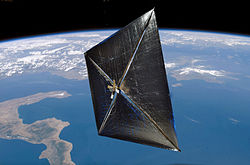- NanoSail-D
-
For the satellite currently in orbit, see NanoSail-D2.
NanoSail-D 
Operator NASA Bus 3U CubeSat Mission type Technology Launch date 3 August 2008
03:34 UTCCarrier rocket Falcon 1 Launch site Omelek Island Orbital decay Failed to orbit Mass 4 kilograms (8.8 lb) Orbital elements Regime Low Earth (planned) Inclination 9° Apoapsis 685 kilometres (426 mi) Periapsis 330 kilometres (210 mi) NanoSail-D was a small satellite which was to have been used by NASA's Ames Research Center to study the deployment of a solar sail in space. It was a three-unit CubeSat measuring 30 by 10 by 10 centimetres (12 × 3.9 × 3.9 inches), with a mass of 4 kilograms (8.8 lb).[1] The satellite was lost shortly after launch due to a problem with the rocket carrying it, however a replacement, NanoSail-D2, was launched in 2010 to complete its mission.
NanoSail-D was to have been deployed on the third flight of the Falcon 1 rocket, which was launched from Omelek Island at 03:34 UTC on 3 August 2008.[2] One of two CubeSats aboard, along with PRESat, it was a secondary payload to the Trailblazer which was to have been operated by the Operationally Responsive Space Office of the United States Department of Defense. The launch was conducted by SpaceX, and also carried a space burial payload for Celestis. Two minutes and forty seconds after launch, the spent first stage of the rocket was jettisoned, however unexpected residual thrust caused it to recontact the second stage, which resulted in the rocket being thrown off course. Unable to achieve orbit, the rocket and payloads fell into the Pacific Ocean.[3]
NanoSail-D was to have been operated in a low Earth orbit with a perigee of 330 kilometres (210 mi), an apogee of 685 kilometres (426 mi) and 9 degrees of inclination. It would have been operational for around seven days,[1] after which time it would have been expected to run out of power. Its solar sail had an area of 10 square metres (110 sq ft).[1] The satellite was developed and tested in four months.[4]
NanoSail-D2 was built as a ground spare for NanoSail-D. Following the launch failure of NanoSail-D in August 2008, NanoSail-D2 was launched as NanoSail-D on a Minotaur IV rocket in November 2010, and deployed from the FASTSAT satellite.
See also
- List of CubeSats
- LightSail-1
References
- ^ a b c Krebs, Gunter. "NanoSail D". Gunter's Space Page. http://space.skyrocket.de/doc_sdat/nanosail-d.htm. Retrieved 20 November 2010.
- ^ McDowell, Jonathan. "Launch Log". Jonathan's Space Page. http://www.planet4589.org/space/log/launchlog.txt. Retrieved 20 November 2010.
- ^ Clark, Stephen (6 August 2008). "Collision between rocket stages doomed Falcon 1". Spaceflight Now. http://www.spaceflightnow.com/falcon/003/update.html. Retrieved 20 November 2010.
- ^ "Sailing Among the Stars". NASA. 17 August 2010. http://www.nasa.gov/mission_pages/smallsats/10-109.html. Retrieved 20 November 2010.
← 2007 · Orbital launches in 2008 · 2009 → Thuraya 3 | TecSAR | Ekspress AM-33 | Progress M-63 | STS-122 (Columbus) | Thor 5 | Kizuna | Jules Verne | STS-123 (Kibō ELM-PS · Dextre · Spacelab MD002) | USA-200 | AMC-14 | USA-201 | DirecTV-11 | SAR-Lupe 4 | Soyuz TMA-12 | ICO G1 | C/NOFS | Vinasat-1 · Star One C2 | Tianlian I-01 | GIOVE-B | Cartosat-2A · TWSAT · CanX-2 · CUTE-1.7+APD II · Delfi-C3 · AAUSAT-II · Compass-1 · SEEDS-2 · CanX-6 · Rubin-8 | Amos-3 | Progress M-64 | Galaxy 18 | Kosmos 2437 · Kosmos 2438 · Kosmos 2439 · Yubileiny | Feng Yun 3A | STS-124 (Kibō PM) | Chinasat-9 | Fermi | Skynet 5C · Turksat 3A | Orbcomm FM29 · Orbcomm FM37 · Orbcomm FM38 · Orbcomm FM39 · Orbcomm FM40 · Orbcomm FM41 | Jason-2 | Kosmos 2440 | Badr-6 · ProtoStar 1 | EchoStar XI | SAR-Lupe 5 | Kosmos 2441 | Trailblazer · NanoSail-D · PRESat · Explorers | Superbird-C2 · AMC-21 | Omid | Inmarsat-4 F3 | Tachys · Mati · Choma · Choros · Trochia | Huan Jing 1A · Huan Jing 1B | GeoEye-1 | Progress M-65 | Nimiq-4 | Galaxy 19 | Kosmos 2442 · Kosmos 2243 · Kosmos 2444 | Shenzhou 7 (Ban Xing) | RatSat | THEOS | Soyuz TMA-13 | IBEX | Chandrayaan-1 (MIP) | Shijian 6E · Shijian 6F | COSMO-3 | Venesat-1 | Chuang Xin 1B · Shiyan Weixing 3 | Astra 1M | Kosmos 2445 | STS-126 (Leonardo MPLM · PSSC-1) | Progress M-01M | Yaogan 4 | Kosmos 2446 | Yaogan 5 | Hot Bird 9 · Eutelsat W2M | Feng Yun 2E | Kosmos 2447 · Kosmos 2448 · Kosmos 2449Payloads are separated by bullets ( · ), launches by pipes ( | ). Manned flights are indicated in bold text. Uncatalogued launch failures are listed in italics. Payloads deployed from other spacecraft are denoted in brackets. Categories:- 2008 in spaceflight
- Satellite launch failures
- Solar-Sail Spacecraft
- CubeSats
- Spacecraft launched by Falcon rockets
- United States spacecraft stubs
Wikimedia Foundation. 2010.
